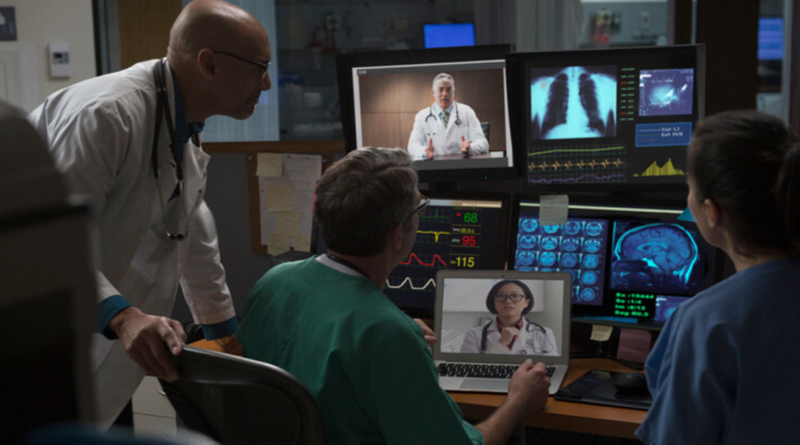In charting a future course for healthcare, let’s think bigger

Angela Jones is a program manager in digital health transformation at Booz Allen Hamilton. This article was co-written with Dr. Kevin Vigilante, chief medical officer at Booz Allen Hamilton.
For the past two years, healthcare agencies have been preoccupied with addressing the immediate priorities of the COVID-19 pandemic. Throughout, they have been dramatically accelerating their adoption of telehealth capabilities to circumvent physical, in-person care limitations imposed by the pandemic. Without realizing it, agencies have taken their first steps towards the promising future of intelligent healthcare.
The confluence of today’s technological advances – in data analytics, digital sensor technologies, 5G networks, artificial intelligence and machine learning, genomic medicine, and elsewhere – offers the potential to transform medicine as we know it.
But of equal importance is the opportunity to transform the visit-based care models of today into new care-delivery paradigms that are connected, agile, personalized, and driven by patient needs. The result will be a shift from institutional-based, episodic, and illness-focused care to a model that promotes wellness through a longitudinal and holistic view of the patient.
Focused on the immediate and overwhelming needs of the pandemic, many healthcare agencies had little choice but to approach virtual care modernization in a real-time and unplanned manner. The result is more of a bolted-on capability than an integrated whole that can truly transform healthcare delivery in ways that improve outcomes, lower costs, reduce health disparities and re-imagine the patient experience to a fully evolved and connected care journey.
By mapping out a clear vision of the future now – the future we aspire to see – we can widen our ambitions and improve our modernization strategies to better harness the vast potential today’s technological advances offer.
The future of healthcare: intelligent, efficient, connected
So, what are some of the aspirational attributes of healthcare we see as we peer into the future?
Healthcare without boundaries. Telehealth services can address geographic and physical barriers by improving access to quality care for patients living in rural and underserved areas, for patients who rely on caregivers for mobility, and shift workers who have difficulty accessing care during standard office hours. People require expert care regardless of where they live and when they need it.
Future care systems will provide a centralized ‘digital front door’ with optimized content and access to channels across multiple devices that can give patients freedom to access care and services in a way that fits their lifestyle. While on the back end, a well architected and integrated network can reduce the information silos that exist today and frequently divide and isolate information from care providers treating the same patient.
These integrated solutions, which provide an omnichannel patient experience across the entirety of the patient journey, can enable healthcare agencies to work from a common operating picture of multiple data sources, mobilizing care teams to quickly deliver insights they need to make ‘whole patient’ decisions.
Proactive, preventative, and personalized care through integrated care teams. Future care systems that are designed for proactive care management can enable a continuum of communication that equips care teams to actively monitor conditions and prevent critical issues.
Biometric sensors can look at trends instead of a single measurement in time, while patient friendly applications can be used for medication reminders or to schedule follow-up appointments. New team-based care models can be configured, calibrated, and personalized around the specific and evolving needs of a patient and clinical decision support tools can alert care teams to intervene for preventative measures.
The benefits span across the care paradigm; patients feel empowered in their health care, caregivers manage responsibilities with increased confidence, and providers deliver more holistic patient care using robust patient generated data to guide their clinical decisions.
Advanced medicine through analytics. Future care systems will process and analyze vast volumes of data, including patient generated data, to deliver a broader array of insights, diagnostic possibilities, and treatment options that can advance the state of medicine. Disruptive technologies based on intelligent sensors, AI engines, and augmented reality have the potential to improve the quality of care by decreasing adverse events and significantly reduce disability and death.
Analytics and automation can also reduce administrative burdens, allowing care providers to focus less on administrative demands and more on interactions with patients. To maximize the value of these insights, it will be critical to weave these analytics into healthcare workflows with user-centered design principles.
At the individual level, these capabilities can translate into earlier and potentially more reliable diagnoses and better treatment options; at the broader population level, it can translate into quicker, data driven insights to improve public health and policy decisions.
Some important considerations
As we begin to design care systems of the future, it is important they add up to more than the sum of their parts. Technology has great potential to improve care, but it also can create the perception of distance between care providers and their patients.
In other words, not everything should be virtual. We must keep in mind the importance of maintaining the human connection between care provider and patient and appropriately choreograph both in person and virtual encounters.
Solutions should be shaped less by the technologies involved, and more by the needs and challenges they’re intended to address. Patients, providers, and staff need to remain at the core of decisions around solution design, and virtual care must fit organically into clinical and operational workflows – not be bolted on as an afterthought.
A clear vision and a roadmap for enterprise-wide integration will be required to seamlessly and securely incorporate the right innovations into adaptable, enduring care pathways.
The vision of future healthcare will look different across agencies. But a common key to success, regardless, is whether the agency employs integration as a defining pillar of its modernization approach.


